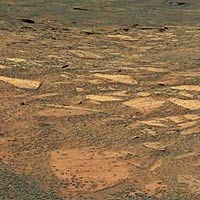Flashing LED Circuit DIY Electronics Kit
$4.99$2.95
Posted on: Jun 9, 2004

Courtesy: NASA/JPL
NASA's Mars Opportunity rover began its latest adventure today inside the martian crater informally called Endurance. Opportunity will roll in with all six wheels, then back out to the rim to check traction by looking at its own track marks.
"We're going in, but we're doing it cautiously," said Jim Erickson, deputy project manager for the Mars Exploration Rovers at NASA's Jet Propulsion Laboratory, Pasadena, Calif. Barring any surprises, Opportunity will enter the stadium-sized crater Wednesday for two to three weeks of scientific studies.
"NASA has made a careful decision. The potential science benefits of sending Opportunity into the crater are well worth the calculated risk the rover might not be able to climb back out," said JPL's Dr. Firouz Naderi, manager of NASA's Mars Exploration Program. "Inside the Endurance crater waits the possibility for the most compelling science investigations Opportunity could add to what it has already accomplished. We have done the ground testing necessary to evaluate the likelihood of exiting the crater afterwards."
"Spirit and Opportunity are well into their bonus periods after successfully completing their three-month primary missions in April," Naderi said. "Both rovers are starting new chapters. Spirit is within a stone's throw of Columbia Hills, and Opportunity is entering the crater."
Dr. Steve Squyres of Cornell University, Ithaca, N.Y., the rovers' principal investigator, said, "We expect the science return of going a short way into Endurance to be very high." The target for inspection within the crater is an exposure of rock layers beneath a layer that corresponds to rocks Opportunity previously examined in the shallower Eagle crater, where the rover landed in January.
The sulfur-rich layer seen in Eagle yielded evidence that a body of gently flowing water once covered the area. The underlying rock layers come from an earlier period. Opportunity's observations from the rim of Endurance already have shown their composition differs from the Eagle crater's layers.
"If there was a change in rock type, there was a change in environment," Squyres said. "This unit will tell us what came before the salty water environment the Eagle crater unit told us about. We want to get to the contact between the two units to see how the environment changed. Is it gradual? Is it abrupt?" Even if the lower layers formed under dry conditions, they may have been exposed to water later. The water's effect on them could have left telltale evidence of that interaction."
One section of the target outcrop is only five to seven meters (16 to 23 feet) from the crater rim in an area dubbed Karatepe. The rover team's plan is to get there, examine the rocks for several days, and then exit the crater. Reaching lower-priority targets, like at the bottom of the crater, would entail driving on sand, with a higher risk of not getting out again.
The strategy for driving on the crater's inner slope is to keep wheels on rock surfaces instead of sand, said JPL rover-mobility engineer Randy Lindemann. The team ran trials with a test rover on a surface specifically built to simulate Karatepe's surface conditions. "The tests indicate we have a substantial margin of safety for going up a rocky slope of 25 degrees," Lindemann said. Opportunity's observations from the rim at the top of the planned entry route show a slope of less than 20 degrees.
Spirit, launched one year ago Thursday, has driven more than 3.2 kilometers (2 miles) inside the Gusev Crater. A trench it dug in May exposed soil with relatively high levels of sulfur and magnesium, reported Dr. Johannes Brueckner, of Max-Planck-Institut fuer Chemie, Mainz, Germany. Spirit's alpha particle X-ray spectrometer showed concentrations of these two elements varied in parallel at different locations in the trench, suggesting they may be paired as a magnesium sulfate salt.
Squyres said, "The most likely explanation is water percolated through the subsurface and dissolved out minerals. As the water evaporated near the surface, it left concentrated salts behind. I'm not talking about a standing body of water like we saw signs of at Eagle crater, but we also have an emerging story of subsurface water at Gusev," he said.
JPL, a division of the California Institute of Technology in Pasadena, manages the Mars Exploration Rover project for NASA's Office of Space Science, Washington, D.C.
For images and information about the Mars project on the Internet, visit http://marsrovers.jpl.nasa.gov & http://athena.cornell.edu.
 'I believe there is no philosophical high-road in science, with epistemological signposts. No, we are in a jungle and find our way by trial and error, building our road behind us as we proceed.'
'I believe there is no philosophical high-road in science, with epistemological signposts. No, we are in a jungle and find our way by trial and error, building our road behind us as we proceed.'